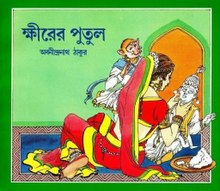Khirer Putul
 Queen and monkey | |
| Author | Abanindranath Tagore |
|---|---|
| Country | India |
| Language | Bengali |
| Subject | Children's Literature |
| Published | 1896 |
Khirer Putul (lit. 'Doll of Kheer') is a children's fantasy novel written by Abanindranath Tagore in 1896.[1][2] Khirer Putul is considered a masterpiece[3] and landmark by writers in Bengali language children's literature.[4] Khirer Putul is a simple and touching tale about the sugar doll, the fate of Duorani and a tricky and extraordinary monkey.[5] Aadi Brahmosamaj press first published this book. Later on, it was translated into other languages.[6][page needed] The story was adapted into a film of the same name by Indian writer and director Purnendu Pattrea in 1976.[7] , an Indian television soap opera based on the novel aired on Zee Bangla in 2020.[8]
It was also adapted into a play by the Indian theatre group Nandikar in 2017, with Anindita Chakraborty as its director.[9]
Plot[]
The king of Deepnagar had two queens Suo Rani and Duo Rani. The king gave Suo Rani 7 palaces, 700 female slaves, best ornaments from 7 kingdoms, 7 gardens, 7 chariots. He neglected Duo Rani and gave her a broken home, a deaf and dumb maid, torn clothes and a dirty bed.
Translations[]
The work has been translated into several languages:
Development[]
Abanindranath who was Rabindranath Tagore's nephew found this story in Mrinalini Devi's diary after her death. The novel is based on the story written in her diary.[14] The illustrations were done by Abanindranath Tagore.[15][page needed]
Analysis[]
According to scholar Sanjay Sircar, the tale can be classified in the Aarne-Thompson-Uther Index as tale type ATU 459, "The Make-Believe Son (Daughter)",[16] a tale type "widespread throughout North India and other Asian areas, but never found in Europe".[17] Similarly, German scholar Ulrich Marzolph (fa) listed four Iranian variants of the same type, which he named Der Prinz verliebt sich in eine Puppe ("The Prince falls in love with a Doll").[18]
References[]
- ^ Children's literature of Bengal. Academy for Documentation & Research on Children's Literature, 1978. 1978.
- ^ Khirer Putul(with Cd). Ananda Publishers Pvt. Limited. ISBN 9788177564990.
- ^ The Modern Review, Volumes 91-92. Prabasi Press Private, Limited. 1952.
- ^ Khirer Putul(Bangla): Bengali eBook, Children Classic. Pathok Publishers Pvt. Ltd. 30 July 2014. ISBN 9788192979809.
- ^ Tagore, Abanindranath. "Khirer Putul". The Pitara.
- ^ ঠাকুর, অবনীন্দ্রনাথ (August 2014). ক্ষীরের পুতুল / Khirer Putul (Bengali): Bengali Children's classic storie. editionNEXT.com.
- ^ Indian Cinema. Directorate of Film Festivals, Ministry of Information and Broadcasting. 1979. p. 66.
- ^ "Khirer Putul". ZEE5.
- ^ "National Theatre Festival 2017". nandikar.net.
- ^ La Poupée de fromage ("Khirère poutoul"). Préface de Selma Lagerlöf. Bois dessinés et gravés par Andrée Karpelès. Éditions Ophrys. 1950.
- ^ Ostdockan: en bengalisk saga. K[oop.] F[örb.]:s Bokförl. 1949.
- ^ "OSTDOCKAN: EN BENGALISK SAGA". biblio.com/.
- ^ Sircar, Sanjay. Fantasy Fictions from the Bengal Renaissance: Abanindranath Tagore, ‘The Make-Believe Prince’ – Gaganendranath Tagore, ‘Toddy-Cat the Bold’. New Delhi: Oxford University Press, 2018.
- ^ Rabindranath Tagore: Puffin Lives. Penguin UK. 15 May 2013. ISBN 9788184759914.
- ^ Ahuja, M. L. (18 December 2012). Eminent Indians: Ten Great Artists. ISBN 9788129127501.
- ^ Zipes, Jack. "Review of Fantasy Fictions from the Bengal Renaissance ed. by Sanjay Sircar". In: Marvels & Tales 34, no. 1 (2020): 121-122. muse.jhu.edu/article/766045.
- ^ Flora, Giuseppe. "Fantasy Fictions from the Bengal Renaissance: Abanindranath Tagore, ‘The Make-Believe Prince’". In: International Research in Children's Literature Volume 14 Issue 1, pp. 123-125. ISSN 1755-6198. Available Online Jan 2021 (https://doi.org/10.3366/ircl.2021.0388
- ^ Marzolph, Ulrich. Typologie des persischen Volksmärchens. Beirut: Orient-Inst. der Deutschen Morgenländischen Ges.; Wiesbaden: Steiner [in Komm.], 1984. pp. 93-94.
External links[]
- Illustration By Ashish Sengupta
- "Khirer Putul". gaana.com. Gaana.com.
- Bengali-language literature
- 19th-century Indian novels
- Indian fairy tales
- Indian children's novels
- 1890s children's books
- Children's fantasy novels
- Indian folklore
- Indian literature
- Indian legends
- Indian novels adapted into films
- Indian novels adapted into plays
- Indian novels adapted into television shows
- Children's novel stubs
- 1890s novel stubs